The traditional instruments of Vietnam were formed and built up along with the establishment and protection of the country. Although each and every single item is made of different materials, giving out a different kind of sound, they all contribute to the diversity of the treasure, resulting in the prosperity of Vietnamese music. In the following, We - Vietnamtrips are pleased to introduce with you the top 7+ most famous and amazing traditional musical instruments in Vietnam.
1 - Đàn đá (Rock Xylophone) - amongst top most special musical instruments of Vietnam
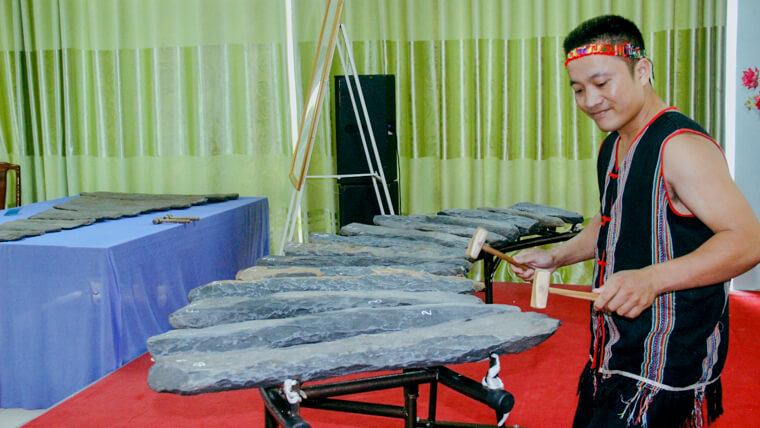
Rock Xylophone - Source: binhphuoc.gov
Đàn đá is the oldest percussion instrument in Vietnam and one of the most primitive musical instruments of mankind. This type of xylophone was discovered in the Central Highlands of Vietnam and is believed to have appeared thousands of years ago. The stones used to make the Đàn đá are often lava rock or horn rock hewn quite delicately and elaborately. They are of different lengths and thicknesses to give out high or low bass scales when being tapped. The long, big, and thick rock bars have low-pitched sounds while the short, small, and thin rocks create soft sounds. In the past, this Vietnamese musical instrument was used to chase away birds and animals, protect crops and later on serve community cultural activities.
The ancient Vietnamese people conceived the sound of the rocks as a means to connect the dead with the living, humans with the universe, and the present with the past. With that sacred meaning, it is performed in important festivals of the people in the Central Highlands.
2 - Đàn T’rưng (Bamboo Xylophone) - one of the most unique instruments of Vietnam
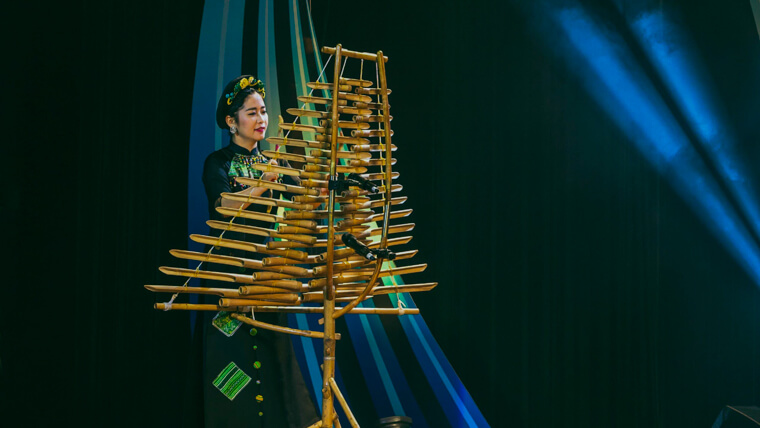
T'rưng Xylophone - Source: heritagevietnamairlines
Đàn T'rưng is a popular percussion instrument in the Vietnam Central Highlands, made of a number of bamboo tubes of different sizes. In common use, it has only 5-7 long tubes, cut and shortened to different lengths. A professional T'Rung xylophone features about 12-16 pipes lined up on the rack. When hit by a stick, they will create different high and low sounds depending on the shape and size of the tubes.
Large and long tubes produce bass, while small and short tubes have high tones. The color of the T'rung Vietnamese musical instrument is a bit opaque, and the sound is not loud and resonant, but it is quite special. The ancients invented the T'rung herd for the purpose of warding off birds, animals, mice in the fields and evil spirits. Things that make T’rưng become one of the most unique instruments of Vietnam is because the Central Highlands people believe that on every bamboo pipe of the lute dwells a god who will help them chase away evil. For that reason, in the past, only men could play the lute in open spaces such as in the fields, in the yards,... but very abstain from playing the T'rung in the house because its sound makes domestic animals such as dogs, chickens, and pigs afraid.
3 - Đàn bầu (Gourd Zither) - top-rated Vietnamese stringed instruments
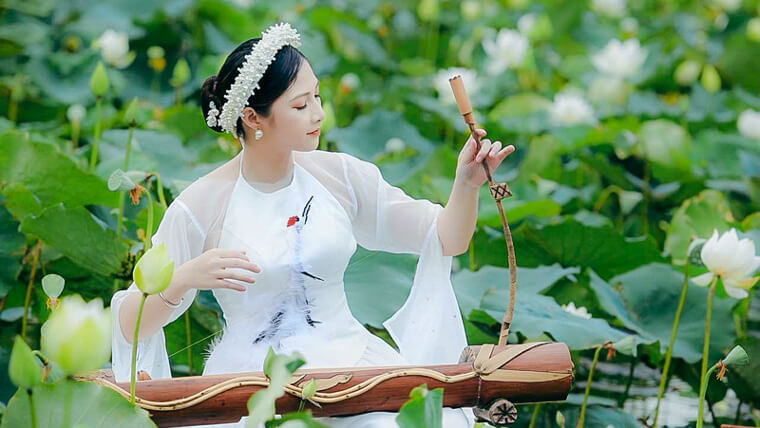
Gourd Zither - Source: hanoimoi
Đàn bầu, also Độc huyền cầm, is one of the most common traditional instruments. Up to now, the birth date of the zither is still a mystery to Vietnamese music researchers; from some historical materials, it is inferred that the instrument was invented thousands of years ago. There are two types of Đàn bầu: the bamboo body and the wooden box. The instrument has only one string running along the body. The strings were first made of silk, later replaced by iron, and Gourd Zither has long become one of the most popular instruments of Vietnam.
The neck used to be made of bamboo, now it is often replaced by buffalo horn. The box is made of dried gourd or wood lathed like a gourd. The winding shaft is made of bamboo or wood, placed close to the player's body. The plectrum is usually sharpened with bamboo, coconut tree trunk, soft wood... People often make it frayed to soften the sound when plucked. If the pitch of the notes emitted by a Western instrument such as a piano or organ is always absolute, the sound of Dan Bau remains between those pitch ranges. Therefore, the sound of Dan Bau is no longer the vibrating sound of silk and steel strings but has changed to be very close to the human voice - that makes this top of special traditional instruments of Vietnam.
In the past, Dan Bau was associated with the art of Xam singing. At that time, the instrument played its role in accompaniment or solo. Later, it was also used by artists in many other traditional singing art forms such as Tuong performances, Cheo performances, water puppet, Hue chamber music, Don ca Tai Tu folk sóng, Cai Luong stage and in harmony with other ethnic instruments..
4 - Đàn nguyệt (Moon lute) - among top unique Vietnamese traditional instruments
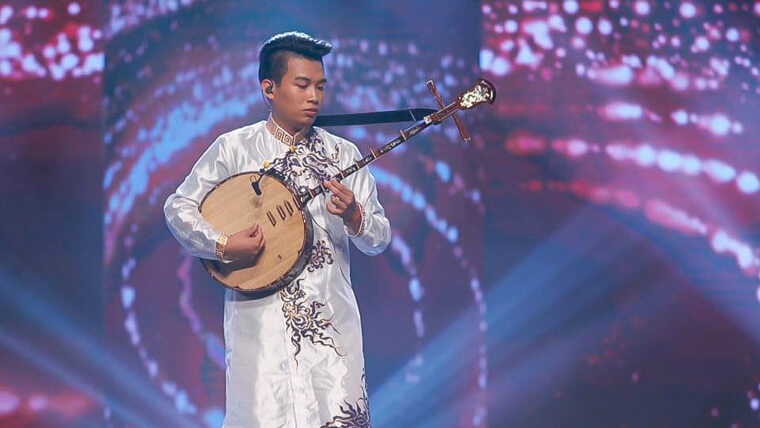
Moon lute - Source: laodong
This type of instrument has a round box like the moon, so it is called a "moon lute". It is widely used in folk music as well as in the traditional court music of the Vietnamese. Appearing since the 11th century, it has become one of top-rated instruments of Vietnam and has always held an important position in the musical practices of the native people, so far.
Đàn nguyệt has a relatively long neck and high keys so that musicians can create flexible and soft sounds. The lute can give out clear and resonant sound, its tone is sometimes lively and sharp, sometimes deep and soft. Therefore, it is present both in solemn concerts, captivating literary performances, mournful funerals, or elegant opera concerts. The way to play is also rich, can be solo, concert, or accompaniment.
5 - Khèn - one of the top famous traditional Vietnamese instruments of Hmong people
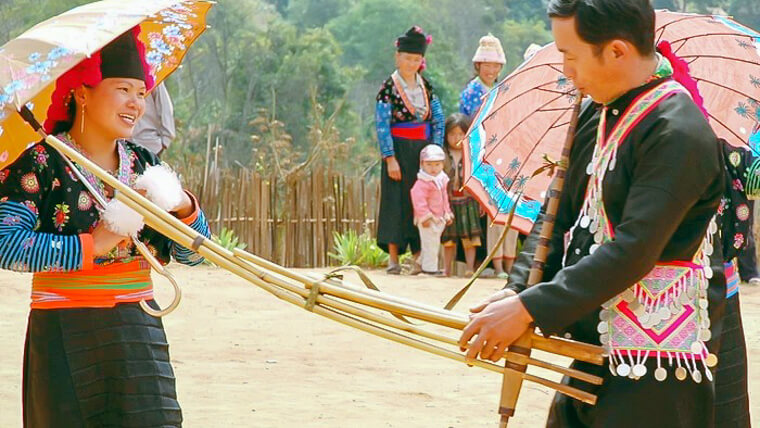
Vietnamese Khèn - Source: phunuvietnam
The advent of Khen originates from an anecdote about a Hmong family with 6 children, each of whom is good at a different musical instrument. Therefore, they decided to create a special one that combines all six of these instruments of Vietnam into one which is Khèn today.
For the H’Mong ethnic group, the Khen is a musical instrument, a prop, and a means of social connection, and emotional expression, helping cultural subjects sublimate with an optimistic spirit of love for life. The Khen belongs to the wind set with a rather complicated structure, consisting of 6 tubes arranged side by side with an end going through a banana blossom-shaped box to make a resonance box.
The Khen has a soft and sharp sound, each tube produces a certain pitch. The inside of the tube has a reed made of copper or inlaid with silver. The Khen is a multi-vocal instrument of Vietnam, with a wide range of about 1.5 octaves. Performing the Khen is a very difficult art because this instrument is not only for blowing but also for dancing with an extremely vivid transformation that requires not only ingenuity but also health. The H'mong people often perform Khen dance when there is a funeral, a death anniversary or a festival. Currently, the Khen dance is also seen in local cultural and artistic activities.
6 - Sáo trúc (Bamboo flute) - one of the most traditional instruments of Vietnam
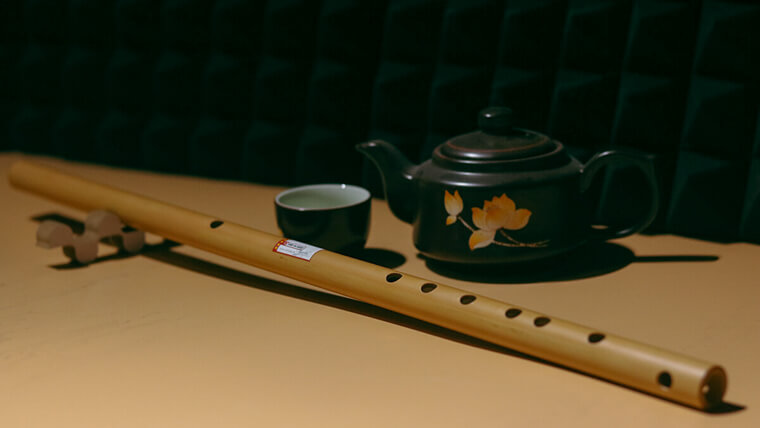
Flute - Source: saotrucbuigia
From ancient to the present, Sáo trúc has always been attached to the cultural and spiritual life of Vietnamese people. The bamboo flute can be not only performed solo but also a part of an orchestra. The material to make this musical Vietnamese instrument is bamboo with a diameter of about 1.5cm and a length of 30cm. The body of the tube is punched with a reed hole, and 6 or 10 punch holes.
In Vietnam, bamboo flutes can be divided into two types: end-blown flutes and side-blown flutes. The bamboo flute can express many nuances of emotions with a wide range of over two octaves. Whether the flute is low or high, it has a clear, fresh timbre, reminiscent of the countryside in Vietnam. However, artists can still use them to express sad melodies.
7 - Cồng - Chiêng (Vietnamese gongs) - one of top Vietnamese percussion instruments

Vietnam central highlands gongs - Source: hutc
Cồng and Chiêng are national percussion instruments of Vietnam, appearing from the Dong Son era (the 7th century B.C to the 1st and 2nd century A.D). The Cồng and Chiêng are cast in an alloy of copper, tin, and lead, shaped like a round hat, about 20cm to 60cm in diameter, with or without a nipple at the center. The one with a nipple is called Chiêng while the one without a nipple is called Cồng. The bigger the instrument is, the lower the sound is and vice versa.
Cồng and Chiêng are present in almost all ethnic groups in Vietnam, especially those living in the Central Highlands. For these people, these two pieces of instruments in Vietnam are indispensable in the life of every person. Once a child is born, every stage of his/her life, from farming to meeting spouse, welcoming guests, moving to a new house or death... is indispensable for the sound of Cồng and Chiêng. The sound of Cồng Chiêng makes listeners feel as if they are seeing the hunting space, farming space, festival space,... of the people in the Central Highlands.
On festival days, the image of people dancing around the sacred fire, beside jars of straw liquor in the sound of gongs echoing the mountains and forests, create a romantic and fanciful space in the Central Highlands. In 2005, the Space of Gong Culture in the Central Highlands was recognized by UNESCO as an Oral and Intangible Masterpiece of Humanity.
8 - Đàn cò (2-stringed bowl-shaped chordophone)
Đàn cò, or Đàn nhị has existed as a part of the traditional musical instruments of Vietnam for a long time. In terms of structure, Đàn cò is a type of string instrument, consisting of five parts: neck, body, handle, bridge, and strings. The first wire shaft hangs down like a stork's beak. Body is nothing different from the torso of a stork. The neck is like a stork’s neck. Even the sharp and clear sound of the harp resembles the sound of the stork as well. Because of that, this Vietnamese instrument is referred to as a stork by the people in South Vietnam.
The Đàn cò has a wide range of 2 octaves, the sound is clear, obvious, and soft. The technique to play the chordophone requires a flexible collaboration between finger strokes, pressing, and vibrations. This is a fundamental element in orchestras such as Hue court music, Chau Van folk songs, Cheo singing, Tuong performing, and Cai Luong acting. Today, the instrument is also used in ballad songs or country music.
Here they are, the greatest musical instruments of Vietnam. What do you think about them? Do you want to see them with your own eyes, hear their sound with your own ears? If so, don’t hesitate to pay a visit to this beautiful country and explore untold stories about its people, culture and wonderful tourist destinations.







.jpg) — Ha Bich
— Ha Bich





































